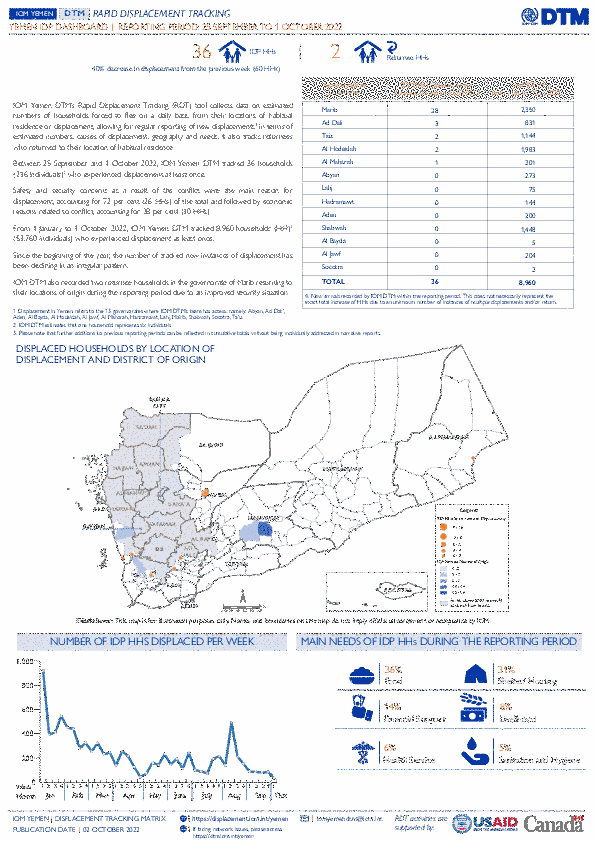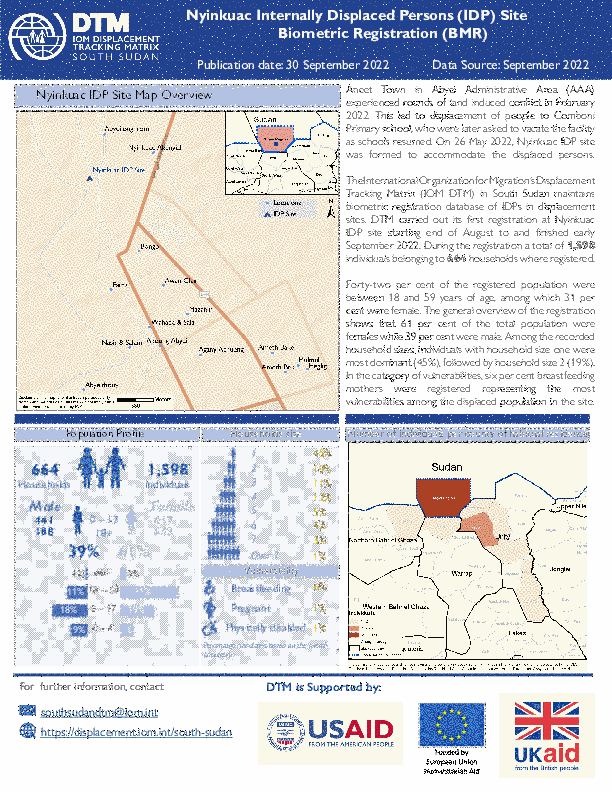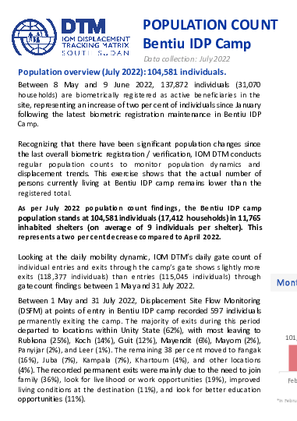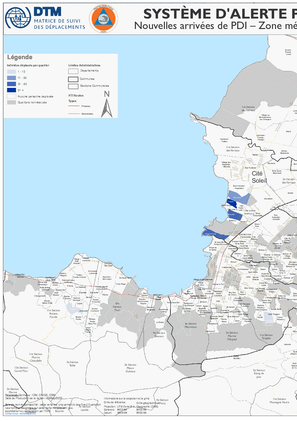-
Countries
-
Data and Analysis
-
Special Focus
-
Crisis Responses
Carte des Nouvelles arrivées des PDI dans la zone métropolitaine de Port-au-Prince, du 30 août - 3 septembre 2022.
Carte des nouveaux déplacements – Zone métropolitaine de Port-au-Prince – 30 août - 3 septembre 2022.
This Middle East and North Africa (MENA) report summarizes mobility restrictions at airports, land, and blue border crossing points resulting from the mitigation measures implemented in response to the COVID-19 pandemic.
Contact
DTM Yemen, iomyemendtm@iom.int
Location
Yemen
Activity
- Mobility Tracking
- Event Tracking
Period Covered
Sep 25 2022 -Oct 01 2022
IOM Yemen DTM’s Rapid Displacement Tracking (RDT) tool collects data on estimated numbers of households forced to flee on a daily basis from their locations of origin or displacement, allowing for regular reporting of new displacements in terms of estimated numbers, geography, and needs. It also tracks returnees who returned to their location of origin.
From 1 January to 1 October 2022, IOM Yemen DTM tracked 8,960 households (HH) (53,760 Individuals) who experienced displacement at least once.
Between 25 September and 1 October 2022, IOM Yemen DTM tracked 36 households (216 individuals) displaced at least once. The majority of people moved into/within the following governorates and districts:
- Marib (28 HHs) – Marib City (20 HHs), Marib (8 HHs) districts. Most displacements in the governorate originated from Shabwah and Al Hodeidah.
- Ad Dali (3 HHs) – Al Azariq (2 HHs), Qatabah (1 HH) districts. Most displacements in the governorate originated from Taiz and Ad Dali.
- Al Hodeidah (2 HHs) – Al Khukhah (1 HH), Hays (1 HH) districts. All displacements in the governorate orginiated from Taiz.
- Shabwah (15 HHs) – Ataq (12 HHs), Nisab (3 HHs) districts.
- Taiz (6 HHs) – Maqbanah (3 HHs), Mawiyah (2 HHs), At Taiziyah (1 HH) districts.
- Al Hodeidah (4 HHs) – Bayt Al Faqih (3 HHs), Az Zaydiah (1 HH) districts.
Population Groups
Survey Methodology
Unit of Analysis Or Observation
Type of Survey or Assessment
Keywords
Geographical Scope
Administrative boundaries with available data
The current dataset covers the following administrative boundaries

Contact
DTM Yemen, iomyemendtm@iom.int
Language
English
Location
Yemen
Period Covered
Sep 25 2022
Oct 01 2022
Activity
- Mobility Tracking
IOM Yemen DTM’s Rapid Displacement Tracking (RDT) tool collects data on estimated numbers of households forced to flee on a daily basis from their locations of origin or displacement, allowing for regular reporting of new displacements in terms of estimated numbers, geography, and needs. It also tracks returnees who returned to their location of origin.
From 1 January to 1 October 2022, IOM Yemen DTM tracked 8,960 households (HH) (53,760 Individuals) who experienced displacement at least once.
Between 25 September and 1 October 2022, IOM Yemen DTM tracked 36 households (216 individuals) displaced at least once. The majority of people moved into/within the following governorates and districts:
- Marib (28 HHs) – Marib City (20 HHs), Marib (8 HHs) districts. Most displacements in the governorate originated from Shabwah and Al Hodeidah.
- Ad Dali (3 HHs) – Al Azariq (2 HHs), Qatabah (1 HH) districts. Most displacements in the governorate originated from Taiz and Ad Dali.
- Al Hodeidah (2 HHs) – Al Khukhah (1 HH), Hays (1 HH) districts. All displacements in the governorate orginiated from Taiz.
The majority of people moved from the following governorates and districts:
- Shabwah (15 HHs) – Ataq (12 HHs), Nisab (3 HHs) districts.
- Taiz (6 HHs) – Maqbanah (3 HHs), Mawiyah (2 HHs), At Taiziyah (1 HH) districts.
- Al Hodeidah (4 HHs) – Bayt Al Faqih (3 HHs), Az Zaydiah (1 HH) districts.

Contact
DTM South Sudan, SouthSudanDTM@iom.int
Language
English
Location
South Sudan
Period Covered
Sep 01 2022
Sep 30 2022
Activity
- Registration
- Biometric Registration
Aneet Town in Abyei Administrative Area (AAA) experienced rounds of land induced conflict in February 2022. This led to displacement of people to Comboni Primary school, who were later asked to vacate the facility as schools resumed. On 26 May 2022, Nyinkuac IDP site was formed to accommodate the displaced persons.
The International Organization for Migration’s Displacement Tracking Matrix (IOM DTM) in South Sudan maintains biometric registration database of IDPs in displacement sites. DTM carried out its first registration at Nyinkuac IDP site starting end of August to and finished early September 2022. During the registration a total of 1,598 individuals belonging to 664 households where registered.
Forty-two per cent of the registered population were between 18 and 59 years of age, among which 31 per cent were female. The general overview of the registration shows that 61 per cent of the total population were females while 39 per cent were male. Among the recorded household sizes, individuals with household size one were most dominant (45%), followed by household size 2 (19%). In the category of vulnerabilities, six per cent breastfeeding mothers were registered representing the most vulnerabilities among the displaced population in the site.

Contact
DTM South Sudan, SouthSudanDTM@iom.int
Language
English
Location
South Sudan
Period Covered
Sep 01 2022
Sep 30 2022
Activity
- Registration
- Biometric Registration
Northern parts of Abyei Administrative Area (AAA) experienced rounds of localized conflict between February and March 2022. This led to displacement of people mostly from Amiet area leading to formation of Bokchop IDP site to accommodate internally displaced people (IDP) who were in search of safety within the neighbourhood of Abyei Town.
The International Organization for Migration’s Displacement Tracking Matrix (IOM DTM) in South Sudan maintains biometric registration database of IDPs in displacement sites. DTM carried out its first registration at Bokchop IDP site in September 2022. During the registration a total of 787 individuals belonging to 318 households where registered.
Forty-two per cent of the registered population were between 18 and 59 years of age, among which 28 per cent were female. The general overview of the registration shows that 52 per cent of the total population were females while 48 per cent were male. Among the recorded household sizes, individuals with household size one were most dominant (46%), followed by household size 2 (14%) and size 3 (14%). In the category of vulnerabilities, breastfeeding mothers were the most recorded individuals (4%).

Contact
DTM South Sudan, SouthSudanDTM@iom.int
Language
English
Location
South Sudan
Period Covered
Jul 20 2022
Jul 22 2022
Activity
- Registration
- Mobility Tracking
- Site Assessment
Rotriak is a location in Budang payam of Rubkona county and was initially a checkpoint for cargo heading to and from Sudan before the 2013 crisis. With the current flood displacement in Unity state, the affected population moved northward and settled in the dry areas at oil fields in Unity state. The area was then officially allocated by local authorities to the affected population as well as individuals who wish to relocate and settle in Rotriak. The demarcated area allocated for the displaced persons is 15 sqaure kilometers. The area is divided into 12 blocks and each block accommodates 280 – 299 plots of land.
On 24th May 2022, IOM’s Displacement Tracking Matrix conducted a rapid assessment to determine the magnitude of the humanitarian situation and estimate the population of Rotriak site. information was collected through Focus Group Discussions, key informant interviews and direct information.
Between 20 and 22 July 2022, IOM conducted population count at Rotriak Site. Blocks (1,2,3,4,5,6,7,8,9,11,12, and 14) are occupied and the total population of the site stands at 27,795 individuals. The population count findings at the eleven blocks show 53 per cent of the population are male, compared to 47 per cent female. Sixty per cent of the IDPs are between 0 – 18 years. Block 4 accommodates the highest number of IDPs (17%), followed by Block 3 (16%), Block 6 (12%), and Block 1 (11%). Almost all (97%) displaced persons cited that they intend to stay at the site.

Contact
DTM South Sudan, SouthSudanDTM@iom.int
Language
English
Location
South Sudan
Period Covered
Jul 01 2022
Jul 31 2022
Activity
- Registration
- Flow Monitoring
- Mobility Tracking
- Site Assessment
As per July 2022 population count findings, the Bentiu IDP camp population stands at 104,581 individuals (17,412 households) in 11,765 inhabited shelters (on average of 9 individuals per shelter). This represents a two per cent decrease compared to April 2022.

Contact
DTM South Sudan, SouthSudanDTM@iom.int
Language
English
Location
South Sudan
Period Covered
Jul 01 2022
Jul 31 2022
Activity
- Registration
- Flow Monitoring
- Mobility Tracking
- Site Assessment
Unity State has been experiencing flooding since 2019 in the counties of Mayendit, Leer, Panyijiar, and Koch. As a result of the flooding in Guit and Rubkona in 2021, Bentiu Town Sites (A, B, C, D, and E) were formed in August 2021. In order to provide accurate information on the Internally Displaced Persons (IDPs), the International Organization for Migration’s Displacement Tracking Matrix (IOM DTM) began conducting monthly population counts in November 2021, including questions on areas of habitual residence, areas of displacement, intentions to return or relocate and demographic information to inform partners.
As per July 2022 population count findings, the Bentiu Town Sites (A, B, C, D, and E) population stands at 57,924 individuals (on average 6 individuals per shelter). This shows a decrease of 194 individuals recorded during this period compared to April 2022.
Between 1 - 31 July 2022, Rapid Flow Monitoring (RFM) at points of entry in Bentiu Town Sites (A, B, C, D, and E) indicates an increase in new arrivals (72%). Twenty-eight per cent are found leaving the sites. Most of the increased new arrivals during this period were recorded in Site E (40%), Site D (18%), and Site C (9%), most of whom came from locations within Unity State (99%), with Guit County (35%), Leer (29%), Rubkona (17%), and Koch (10%), and others (9%). IDPs arriving at the sites travelled using boats (48%) or came by foot (41%).


